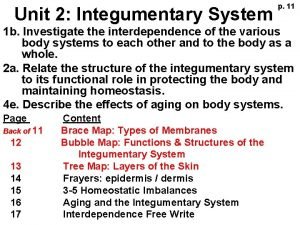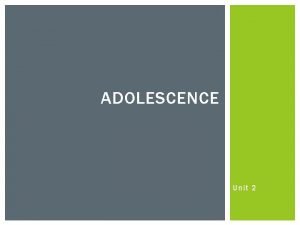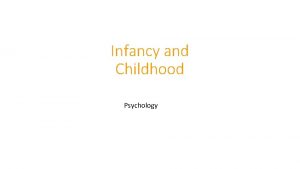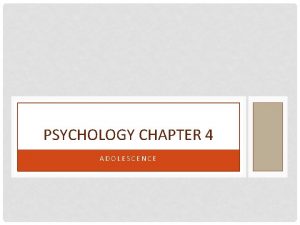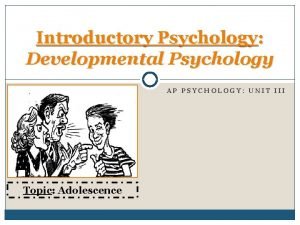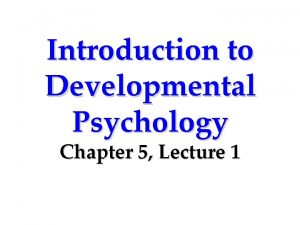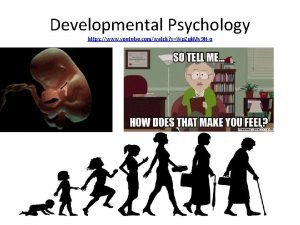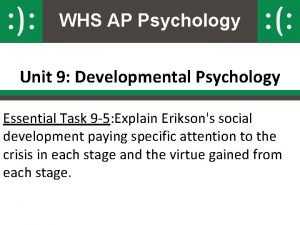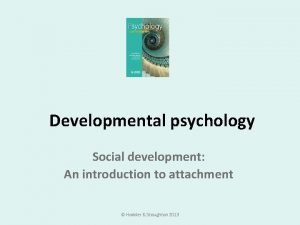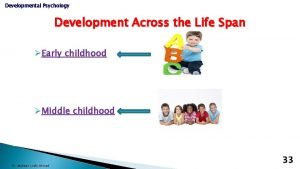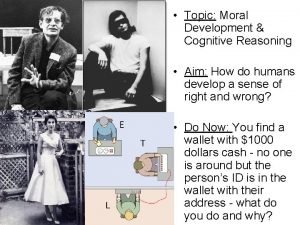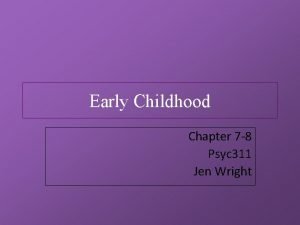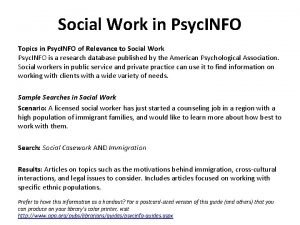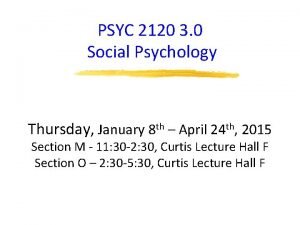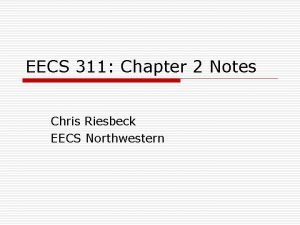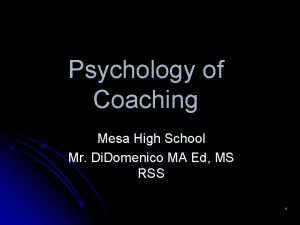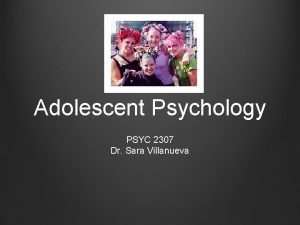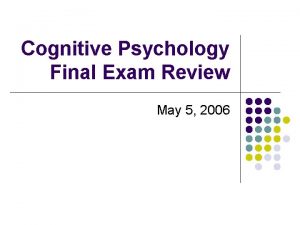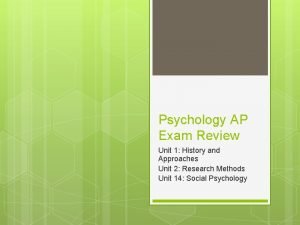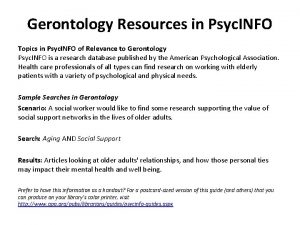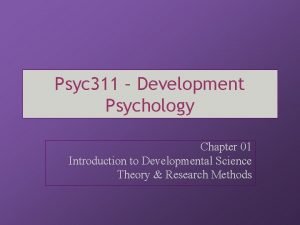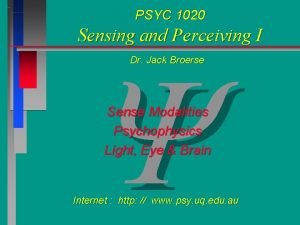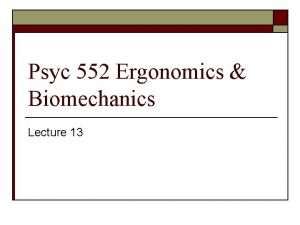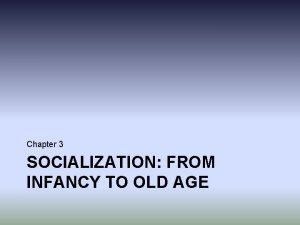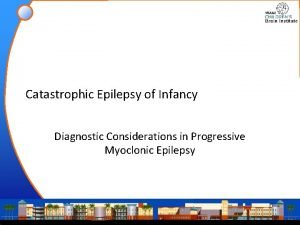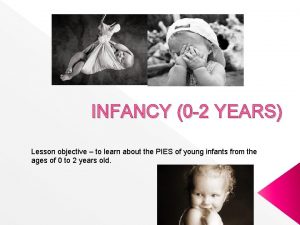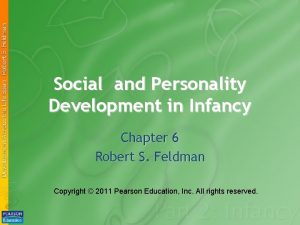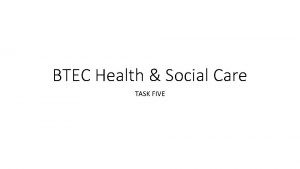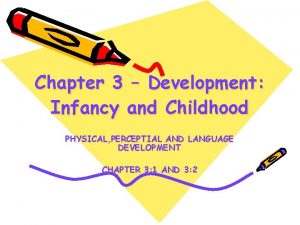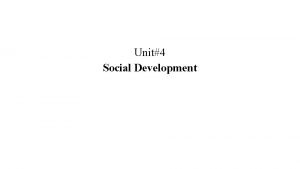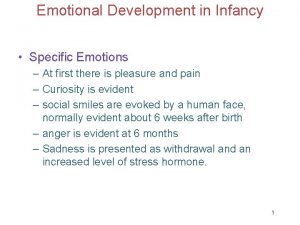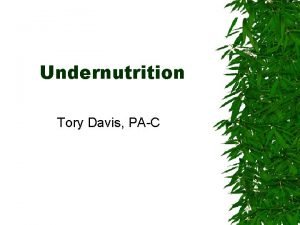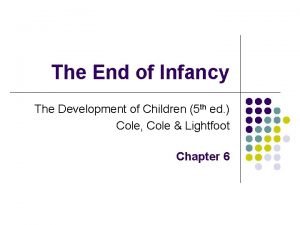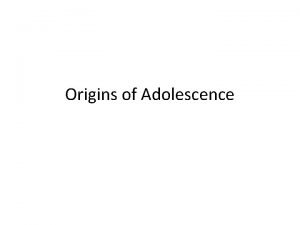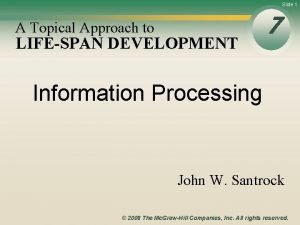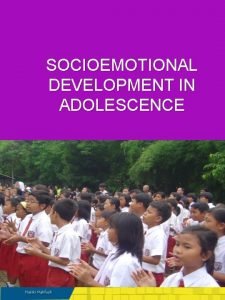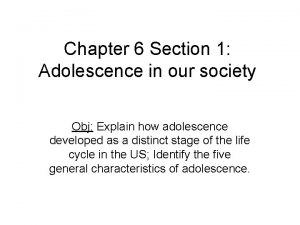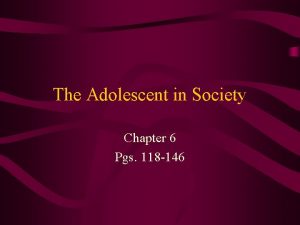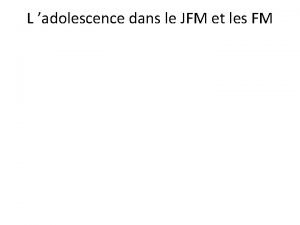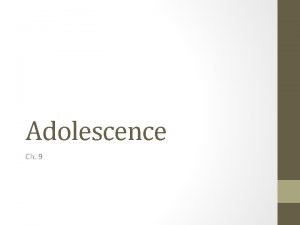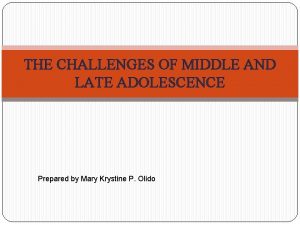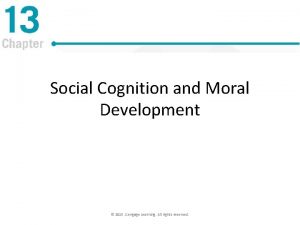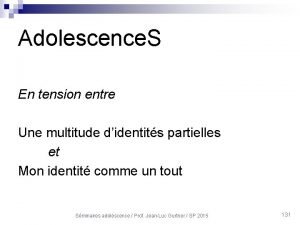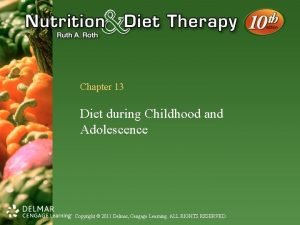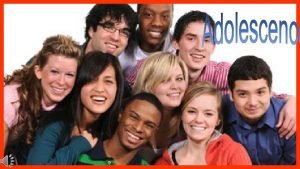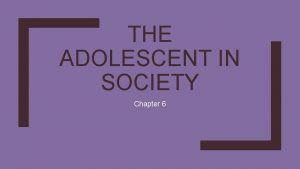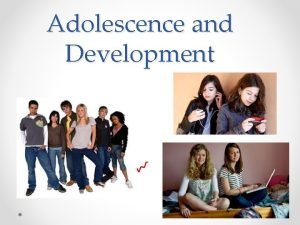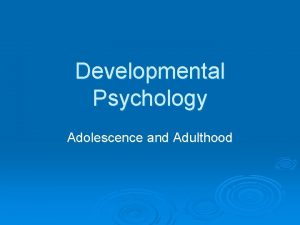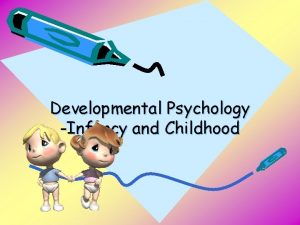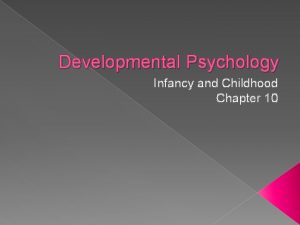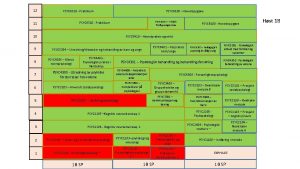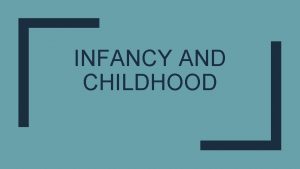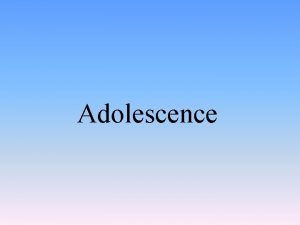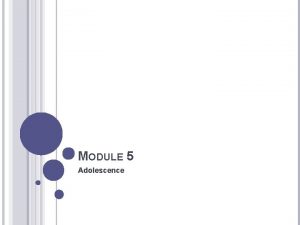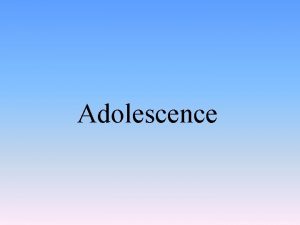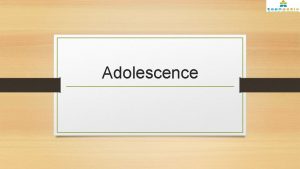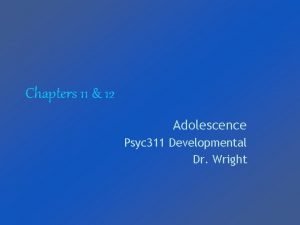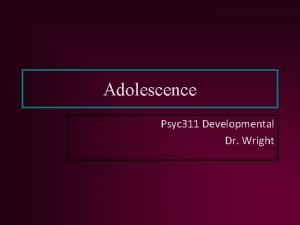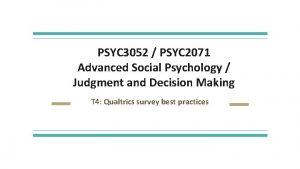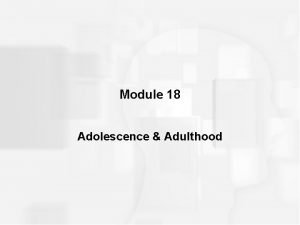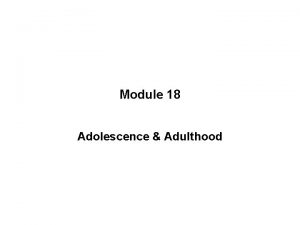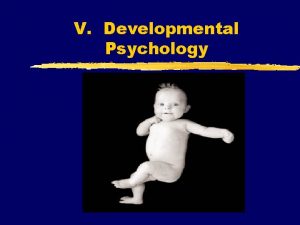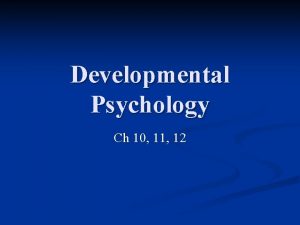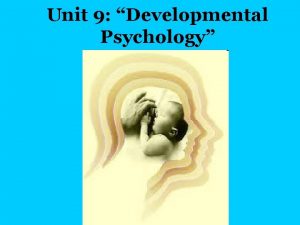Developmental Psychology Infancy to Adolescence Ch 11 Psyc













































































- Slides: 77

Developmental Psychology: Infancy to Adolescence Ch 11 Psyc 103 Dr. Jen Wright

infant brain

one of the last organs to develop… How much brain development has been completed at birth? A) 100% B) 75% C) 25%

developmental processes

patterns of brain growth

effect of deprivation

effect of deprivation

importance of sleep • REM sleep – critical for neural development in brain, esp. for activitydependent development – E. g. visual system – Facilitates learning/memory • Sleep deprivation linked with later problems – E. g. ADHD, learning disabilities • Babies most at risk of disruption – Premature infants in IC units

importance of sleep

stress and brain development • Exposure to excessive stress hormones is bad for brain development. • Early symptoms of PTSD • The brain can become incapable of producing normal stress responses. – Hyper-vigilance (Ghosts in the Nursery) – Emotional flatness • Physical/emotional abuse and neglect can be equally damaging.

attachment

attachment theory • Attachment refers to the close, emotional bond between an infant and his/her primary caregiver. • Psychoanalytic Theory (Freud) – Driven by oral needs during the first year – Emphasized early experiences on later outcomes • Behaviorist Perspective (Skinner) – Driven by the need for food – Learns to associate contact with mother with food • Mother’s closeness continually reinforced

attachment theory • Ethology (Lorenz) – Rooted in Darwin’s evolutionary theory – Focused on the adaptive value of behavior – Imprinting • Bond necessary for survival

primary criticisms • Love (i. e. , attachment) seen as secondary to instinctive or survival needs • John Bowlby: observations of children in institutionalized care – Harlow believed that the need for love and affection was necessary for survival

Harlow’s monkeys (1958) • Early work with monkeys • Cloth & wire mother – Only one equipped with feeding apparatus – Monkeys randomly assigned – Observed for 5 months • Both groups preferred cloth mother

24 18 . . . . 12 Mean hours per day . 6 0 . Infant monkey fed on cloth mother Infant monkey fed on wire mother Hours per day spent with cloth mother Contact Time with Wire and Cloth Surrogate Mothers . . Hours per day spent with wire mother. . 1 -5 11 -15 21 -25 6 -10 16 -20 Age (in days)

Harlow’s monkeys (1958) • http: //www. youtube. com/watch? v=hs. A 5 Sec 6 d. AI • http: //www. youtube. com/watch? v=ca. M 4 f 6 ZZBE&feature=related

attachment theory • Serves 2 purposes – Secure base – Internal working model • Mary Ainsworth (1979) – Developed Strange Situation – Work revealed 4 types of attachment behavior • • Securely Attached Insecure Avoidant Insecure Resistant Insecure Disorganized – http: //www. youtube. com/watch? v=QTsew. Nr. HUHU

internal working model

cultural variation

social learning

facial recognition


mirror neurons • Found in the frontal and parietal lobes • Fire when you A) You engage in an activity (reaching out one’s hand) B) You observe someone else engaging in the same activity. C) Both D) Neither • True/False: Fire more strongly when action has some purpose or content – reaching out one’s hand for a cup.


emotional development

crying • Crying – communication of emotion • Response to distress – Development of emotional self-regulation • Mastery of environment – agency • Biofeedback loop • Soothing – – – Swaddling – tight wrapping of baby in cloth Touch Sweet taste Soft, rhythmic sounds Vibration

crying disorders • Colic (1 in 10 infants; birth – 12 weeks) – Extended periods of intense crying – Cause unknown • Digestive problems • Immature nervous system – Hyper-sensitivity • Prolonged crying (beyond 12 weeks) – Exhibit developmental and behavioral disorders – PTSD symptoms in babies • Stress hormones damage hippocampus • Cause hyper-vigilance

early emotional expression • Earliest emotion – global arousal states of attraction and withdrawal – set the stage for further development – develop into well-organized, sustained signals • Basic emotions – emotions that can be directly inferred from facial expressions. • happiness, interest • surprise, fear, anger • sadness, disgust

Basic emotions: A) Universal across all human cultures B) Present in other advanced species C) Include guilt, shame, embarrassment D) A&B E) All of the above

emotional self-regulation • Strategies for adjusting emotional state to a comfortable level of intensity in order to accomplish goals • • Infants: withdrawal, distress, crying -- need soothing 4 mos: shift focus of attention 1 year: approach/retreat from stimulus Parents response to distress is important • Sympathetic – child more easily soothed, more self-regulated • Non-responsive (wait to intervene) – child enters into rapid, intense distress – harder to soothe – doesn’t develop self-regulation

emotional self-regulation • When an infant’s needs are met, they can focus on the world around them and explore. – Their brains take in and adapt to stimulation from the external world. • When they aren’t met, they become fixated on trying to get their needs met. – They stop exploring and shut other stimulation from the external world.

emotions of others • Emotional contagion: babies match the emotional expressions of caregiver – Still face experiment – http: //www. youtube. com/watch? v=apz. XGEb. Zht 0 • Social referencing: relying on another person’s emotional reaction to appraise situation – Visual cliff – http: //www. youtube. com/watch? v=eyx. Mq 11 x. Wz. M

Mirror neurons help infants experience others’ emotions: A) Yes, because they help them match emotional facial expressions B) Yes, because they stimulate a matching internal experience C) Yes, because they allow infants to empathize with others. D) A&B E) No, because mn’s are only involved in imitation of physical behavior

emotions and self-development Emotions are important in the emergence of selfawareness • Self-efficacy – awareness that you can affect events in your surrounding • Self-control – learning to modulate emotional reactions • Self-concept – episodic memories – external vs. internal characteristics

emergence of the conscience • Self-regulatory emotions – – Guilt/Shame Embarrassment Pride Disgust • Awareness of expectations/reactions of others • Important distinction between shame and guilt. • What is the difference? • Why do we call these emotions “moral emotions”? – moral awareness - sense of good vs. bad – Inhibition of bad behavior, promotion of good behavior

empathy • May be more important for moral socialization than negative emotions • Global distress in infants – Emotional contagion • Egocentric empathy (2 yrs) • Non-egocentric empathy (3 yrs+) • Cognitive empathy (middle childhood) – Abstract perspective-taking

temperament

temperament • Constitutionally based individual differences in – Emotion – Motor function – Attentional reactivity – Self-regulation • Influences the way that children develop, display, and control emotions – Foundation for later personality

temperament styles • Types – Easy – Difficult – “Slow to warm up” Which child will be harder to reward/punish? A) Easy child B) Difficult child • Differences in sociability • Differences in punishment/reward

temperament styles • What else affects the development of temperament? • Gender • Cultural differences • Goodness of fit (with parents/environment)



body development

eating habits • 2 -6 year olds eat less than infants and older children. • “Just right” phenomenon – picky eaters! – Like: salty/sweet foods – Dislike: bitter/sour foods • Learning what is appropriate and not appropriate to eat • Early signs of disgust – Infants show “disgust” facial expression – Strong food preferences



role of disgust • Protection against dangerous substances – Poisonous foods often bitter – Rotten foods often sour – Disgust expression functions as warning • Protection against contamination – Children not sensitive to contamination until early childhood • Protection against deformity and disease

role of disgust • Higher-order disgust • Physical contamination social contamination – 7 -8 year olds “cooties” • Physical contamination moral contamination • Examples?

obesity • Early signs of obesity as young as 2 years old • Obesity rates among 2 - to 5 -year-olds – rose to 14% for the years 2003 -2006 – compared with 5% in 1980 • Need less food than did as an infant – Problem forcing child to “clean their plate” – Especially w/ desert as an incentive! • Attraction to salty and sweet foods • Other contributors?

consequences • Type II diabetes – 50% of some children in low-income areas • Bone development problems – Stunted hip/leg bone growth • • Cardiovascular disease HBP, High cholesterol Lower IQ Obesity programs for toddlers? – http: //abcnews. go. com/Health/Story? id=5602922&page=1

developing cognition

• http: //www. youtube. com/watch? v=w. WW 1 vp z 1 ybo&feature=related


sort by color



sort by shape


• Increase in “executive function” • Results in increased impulse control – Delayed gratification – Perseverance • Results in ability to override current intentions given new information – Color/shape card sorting game • Memory development – Still better memory for content than context • No memory of when/where something is learned

Maxi “false-belief” tasks ? ?

succeeding at the false belief task… Requires understanding that Maxi • A) has a mental state (belief) that is different from the child’s mental state. • B) has a mental state (belief) that is different from reality. • C) neither • D) both

appearance-reality tasks




• What is the driving force behind this development? • Brain maturation – Plasticity • Cognitive exploration – Piaget – Vygotsky

Piaget • Child as Scientists • Children learn on their own • Children are intrinsically motivated to learn • Language and education play only minimal roles

Vygotsky • Children as Apprentices • Child learns through social interaction • Children are socially motivated to learn • Language and education play central roles

• Children as apprentices – guided participation

scaffolding • temporary support that is tailored to a learner’s needs and abilities • aimed at helping the learner master the next task in a given learning process

zone of proximal development (ZPD) • The skills that we can exercise only with assistance, not yet independently. • ZPD applies to the ideas or cognitive skills we are close to mastering as well as to more apparent skills. • Examples?

Get into the “zone” – otherwise known as “flow”.

parenting

parenting styles • Authoritarian: restrictive style in which parents demand obedience and respect • Parent places firm limits and does not allow discussion • Parent rigidly enforces rules but rarely explains them • Children are often unhappy, fearful, and anxious • Authoritative: encourages children to be independent while placing limits and controls on actions • Extensive verbal give-and-take • Parents expect mature, independent, age-appropriate behavior • Children are often cheerful, self-controlled, and self-reliant

parenting styles • Neglectful: parent is very uninvolved in child’s life • Children feel that other aspects of the parent’s life are more important than they are • Children tend to be socially incompetent, immature, and have low self-esteem • Indulgent: parents are highly involved but place few demands or controls on the child • Children never learn to control their own behavior and always expect to get their way

Two Dimensions: • Responsiveness • Demandingness The best parenting style is: A) Indulgent B) Authoritarian C) Neglectful D) Authoritative parenting mirrors Vygotsky’s zone of proximal development.
 Infancy childhood adolescence adulthood old age
Infancy childhood adolescence adulthood old age Middle childhood years
Middle childhood years Adolescence
Adolescence Chapter 10 infancy and childhood
Chapter 10 infancy and childhood Chapter 10 infancy and childhood review worksheet answers
Chapter 10 infancy and childhood review worksheet answers Infancy and childhood psychology
Infancy and childhood psychology Psychology chapter 10 infancy and childhood
Psychology chapter 10 infancy and childhood Chapter 4 adolescence psychology
Chapter 4 adolescence psychology Chapter 4 adolescence psychology
Chapter 4 adolescence psychology Adolescent age range psychology
Adolescent age range psychology Chapter 5 developmental psychology
Chapter 5 developmental psychology Research methods in developmental psychology
Research methods in developmental psychology Ucf online psychology
Ucf online psychology Wilhelm wundt structuralism
Wilhelm wundt structuralism Sublimation psychology
Sublimation psychology Unit 9 developmental psychology
Unit 9 developmental psychology Devonte is a graduate student in developmental psychology
Devonte is a graduate student in developmental psychology What was john bowlby attachment theory
What was john bowlby attachment theory Animism examples psychology
Animism examples psychology Lawrence kohlberg developmental psychology
Lawrence kohlberg developmental psychology Authoritariam
Authoritariam Psyc 311 study guide
Psyc 311 study guide Psyc info
Psyc info Psyc 2120
Psyc 2120 Chris riesbeck
Chris riesbeck Psyc info
Psyc info Sfu criminology major
Sfu criminology major Psyc 1504 learning journal unit 1
Psyc 1504 learning journal unit 1 Psyc 2307
Psyc 2307 Psychology final exam review
Psychology final exam review Psyc 1504 final exam
Psyc 1504 final exam Psyc info
Psyc info Psyc 311
Psyc 311 Psyc 1020
Psyc 1020 Physiology ergonomics
Physiology ergonomics Gratification disorder
Gratification disorder Module 47 infancy and childhood cognitive development
Module 47 infancy and childhood cognitive development Stages of socialization
Stages of socialization Stages of developmetn
Stages of developmetn Age
Age Catastrophic epilepsy infancy
Catastrophic epilepsy infancy Socioemotional development in infancy
Socioemotional development in infancy Chapter 5 cognitive development in infancy and toddlerhood
Chapter 5 cognitive development in infancy and toddlerhood Pies in infancy
Pies in infancy Social development in late childhood
Social development in late childhood Personality development in infancy
Personality development in infancy Module 46 infancy and childhood physical development
Module 46 infancy and childhood physical development Intellectual health and social
Intellectual health and social Infancy psychosocial development
Infancy psychosocial development Problems of infancy
Problems of infancy Infancy and childhood physical development
Infancy and childhood physical development Infancy physical changes
Infancy physical changes Social development in infancy
Social development in infancy Messianic prophecies fulfilled in the infancy narratives
Messianic prophecies fulfilled in the infancy narratives Lesson quiz 3-2 infancy and childhood
Lesson quiz 3-2 infancy and childhood Module 47 infancy and childhood cognitive development
Module 47 infancy and childhood cognitive development Emotional development in infancy
Emotional development in infancy Infant personality development
Infant personality development Infancy
Infancy Infancy period
Infancy period Eduard spranger dominant values theory
Eduard spranger dominant values theory Fast mapping
Fast mapping Needs of adolescence
Needs of adolescence Critical thinking in adolescence
Critical thinking in adolescence ________ is a self-portrait composed of many pieces.
________ is a self-portrait composed of many pieces. Integrity and despair
Integrity and despair Adolescence in our society
Adolescence in our society Undefined status adolescence
Undefined status adolescence Caloub
Caloub Erikson's stage of adolescence
Erikson's stage of adolescence Moral development in adolescence
Moral development in adolescence Challenges of middle and late adolescence
Challenges of middle and late adolescence Moral development in adolescence
Moral development in adolescence Les avantages de l'adolescence
Les avantages de l'adolescence Eating a balanced diet during childhood and adolescence
Eating a balanced diet during childhood and adolescence Adolescene period
Adolescene period Importance of adolescence
Importance of adolescence Adolescence
Adolescence
